Find out about the Data Manager component in SAP BusinessObjects Planning and Consolidation, which is used for importing and exporting data as well as executing background tasks. See how using dynamic process chains in Data Manager helps you complete planning tasks more quickly.
Key Concept
All functionality in SAP BusinessObjects Planning and Consolidation is designed with the business user in mind, and Data Manager is no exception. Traditionally, tasks such as extracting and loading data from a source system are solely IT’s responsibility — but not with SAP BusinessObjects Planning and Consolidation. In fact, Data Manager has been woven into the SAP BusinessObjects Planning and Consolidation Excel client, so you do not need to learn any new tools or technology to begin using it.
Data Manager is an SAP BusinessObjects Planning and Consolidation module that helps you manage loading, transforming, and manipulating data. Within the version for SAP NetWeaver, Data Manager runs on top of the SAP NetWeaver BW process chain framework. That means when you execute an SAP BusinessObjects Planning and Consolidation Data Manager package (described in detail later), it triggers a process chain to execute as well.
In the version for the Microsoft platform, Data Manager looks and behaves the same in the SAP BusinessObjects Planning and Consolidation Excel client, but it actually runs on top of the Microsoft product SQL Server Integration Services (SSIS). As with all components in SAP BusinessObjects Planning and Consolidation, the complexity of the back end has been hidden from the user, which is why the user interface looks identical between the two different applications (SAP NetWeaver and Microsoft). The purpose of this article is to introduce you to the Data Manager terms and concepts, and relate that back to how it involves process chains in SAP NetWeaver BW.
Data Manager Fundamentals
To access Data Manager, open the Excel client and choose Manage Data in the Action Pane. Figure 1 shows the list of Data Manager options that are available.

Figure 1
Data Manager options in the SAP BusinessObjects Planning and Consolidation, version for SAP NetWeaver Excel client
The main concept to understand in Data Manager is the Data Manager package. A package is what a user executes or schedules to perform a required task. Basically, any task that you would run as a background job to load, manipulate, or export data would all be Data Manager packages. For example, some typical packages might be Import a Flat File, Perform an Allocation, or Copy Data. Figure 2 shows an example set of Data Manager packages that the user can choose to execute. You access this screen by selecting the Run a data management package option in Figure 1.
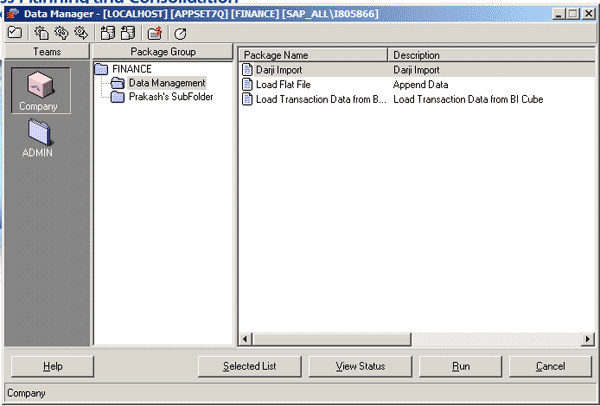
Figure 2
Select a Data Manager package to execute
A Data Manager package maps directly to an SAP NetWeaver BW process chain. That is why running a Data Manager package from the front end triggers a process chain to execute in the back end. So, for now at least, you can think of a package as being a simple wrapper over the top of a process chain.
Note
Although we imagine most readers are familiar with BW terminology, just to make sure:
- A process type is an individual task in SAP NetWeaver BW (such as Execute InfoPackage, Drop Indexes, or Send Email).
- A process chain is the orchestration of process types into a logical sequence for execution. Process types are not executed directly, but must always be placed in a process chain, which you then execute.
Many new process types are delivered with SAP BusinessObjects Planning and Consolidation and are installed during the overall installation process (Figure 3). In fact, not only are new process types delivered, but complete process chains are also installed with SAP BusinessObjects Planning and Consolidation. This may seem a bit strange at first because in SAP NetWeaver BW, a process chain is usually specific to your company. That is, the variants you must create for each process type specify information such as the technical name of an InfoProvider and the name of an InfoPackage, which are specific to your environment only.
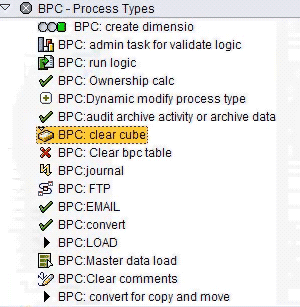
Figure 3
Some of the delivered process types for SAP BusinessObjects Planning and Consolidation, version for SAP NetWeaver
You might wonder how it could be useful for SAP to deliver process chains when all these variants must specify the names of customer specific objects. The answer is that SAP BusinessObjects Planning and Consolidation actually delivers and uses what we call dynamic process chains.
Dynamic process chains are built exactly the same way as traditional process chains, but the difference is that parameter values are able to be passed into them at runtime. If you take the example Data Manager package of Load a Flat File, this means that you can pass the name and location of the flat file, as well as the name of the target InfoProvider, to the process chain at runtime. In a traditional process chain, you would have to have a new process chain for each different file. In SAP BusinessObjects Planning and Consolidation, you can upload any flat file to any InfoProvider through a single process chain and pass these parameters dynamically.
The parameters that you need to pass depend on which process chain the system calls. If you are familiar with any programming language, you can think of SAP BusinessObjects Planning and Consolidation treating a process chain like a function that accepts parameter values to be passed into it.
Passing Parameters
At this point, you might be wondering where exactly these parameters are actually coming from. There are four ways to obtain the parameter values:
- You can prompt users executing the Data Manager package to fill out some of the values. To continue our example of uploading a flat file, you might prompt the users to select which specific file they want to upload.
- The Data Manager package comes with a number of system variables that can be used without having to prompt the user. Examples include the user names of the users executing the package or the name of the AppSet in which they are working, for example. Nobody needs to tell the system where to get these values from as the logic on how to derive them is already built into the product.
- You can hardcode values in the Data Manager package itself. Because it is defined in the Data Manager package (and not the process chain), the value can still be changed in the Excel client without having to log in to SAP NetWeaver BW directly. You would typically use this option when the administrator wants to control the value, but it’s not a parameter that you would want to prompt end users for. As an example, if you automatically want some business logic to run after the file has been uploaded, you may prompt the user for the file name, but hardcode which logic should be executed afterwards.
- The final option is to hardcode the value in the process chain definition. This is akin to how process chains are traditionally built, but it offers the least flexibility from the SAP BusinessObjects Planning and Consolidation point of view. You should use this option when parameters are too technical to be exposed to SAP BusinessObjects Planning and Consolidation or for parameter values that rarely change (for example, you might hardcode the package size).
It is common that all four of these options are used on the same Data Manager package (i.e., some values are supplied by the end user and others are hardcoded in the package or process chain). Figure 4 shows what executing a Data Manager package might look like to an end user. This screen shows the Data Manager package prompting the user to supply different values, including the name and location of the flat file, for example.
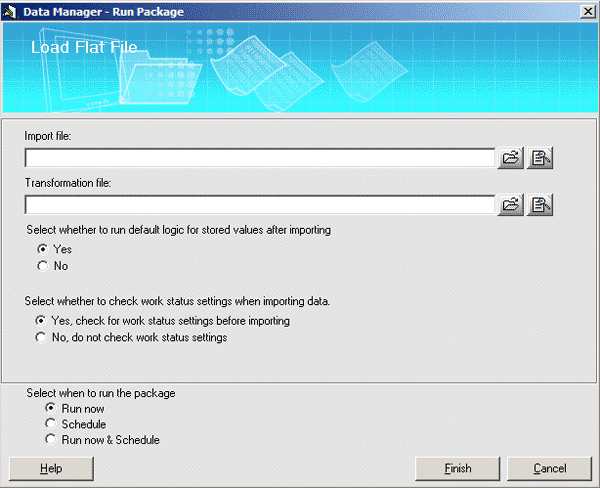
Figure 4
Prompts displayed to the user executing an example Data Manager package
When the user has finished filling out the requested fields, the values are passed to the SAP NetWeaver BW process chain for scheduling or execution. This is the first method of passing parameters as described previously.
The system knows which process chain to execute based on which Data Manager package the user selected. Figure 5 shows the Data Manager package definition in which its properties —such as the package text description and the process chain’s technical name — are defined.

Figure 5
An example Data Manager package definition
The other important parts of the Data Manager package definition are where the parameter values are coming from (i.e., should the end user be prompted or should the values be hardcoded) and how they should be passed to the process chain. To handle this part, Data Manager has its own small scripting language. This language allows you to build the screens shown to the end user. For example, the screen displayed in Figure 4 was built using the Data Manager scripting language. Figure 6 shows the corresponding script required to build that screen.
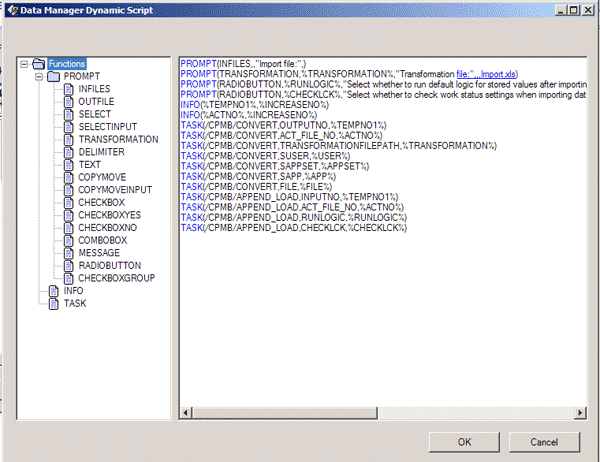
Figure 6
An example script for a Data Manager package
On the left side of Figure 6, you can see a number of available keywords. For example, there are different types of PROMPT keywords, such as INFILES (select a flat file to load), CHECKBOX, and RADIOBUTTON. There is also a keyword called TASK, which is where values are passed to the process chains’ parameters. To see an example of this in Figure 6, the process type /CPMB/CONVERT has many parameters for which it needs values, one of which is the application in which the user wants to load the file. The name of this process type parameter is called SAPP. In this case, you can access the target application to which you want to load the file from a system variable called %APP%. This is an example of the third option for passing parameters described earlier.
In Figure 7 you can see the corresponding Convert process type in SAP NetWeaver BW, in which all the different parameters, including SAPP, are defined. You can also see how some of the parameters (such as Data Package Size) have been hardcoded in the process chain itself (in this case, to 40,000 records).
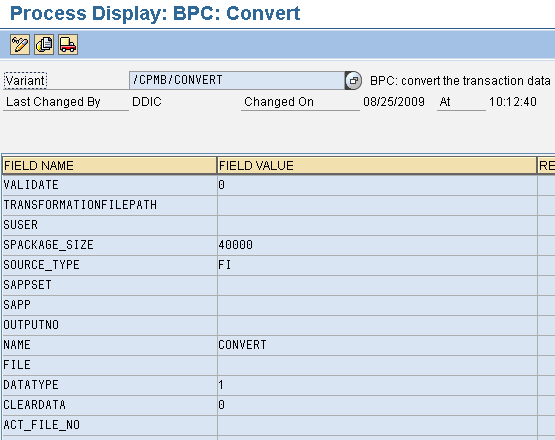
Figure 7
The parameters for the Convert process type, as used in the process chain for loading a flat file
There are many delivered process types, process chains, and Data Manager packages, and this level of flexibility means a broad range of functionality is provided straight out of the box — you do not need to log into SAP NetWeaver BW to create new process chains, nor are you forced to learn the Data Manager scripting language. Of course, it is also possible to build new process chains (or even new process types) for your SAP BusinessObjects Planning and Consolidation system should the need arise, but the use of dynamic process chains helps keep your system flexible to support changing business requirements.
Ryan Leask
Ryan Leask currently runs the SAP BusinessObjects Planning and Consolidation solution management team for SAP, based out of Palo Alto, CA. Prior to this position, he led the EPM solution architecture team with a main focus on the design of SAP BusinessObjects Planning and Consolidation 7.0, version for SAP NetWeaver. Ryan has also worked on SAP xApp Analytics, SAP NetWeaver Visual Composer, SAP NetWeaver BW, SAP SEM, ABAP, SAP CRM, analytics/data mining, and whatever else seemed interesting. He has also co-authored SAP xApp Analytics (SAP PRESS, 2006), written many articles, and presented at numerous conferences.
You may contact the author at ryan.leask@sap.com.
If you have comments about this article or publication, or would like to submit an article idea, please contact the editor.

Prakash Darji
Prakash Darji is an experienced professional with more than 10 years of end-to-end experience in enterprise software. He has a broad depth of experience including corporate strategy, sales, product management, architecture, and development. He has experience in product launch activities, including positioning, packaging, and pricing. He has delivered numerous product releases in a variety of capacities through his career. He thrives on building high-performing, scalable teams to achieve strategic deliverables, whether they close strategic sales deals, roll in product features, or roll out new releases. He is a recurring author for several publications and a speaker at SAP conferences around the world. Prakash is on LinkedIn at https://www.linkedin.com/in/prakashdarji.
You may contact the author at editor@BIexpertOnline.com.
If you have comments about this article or publication, or would like to submit an article idea, please contact the editor.












